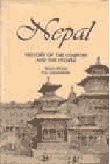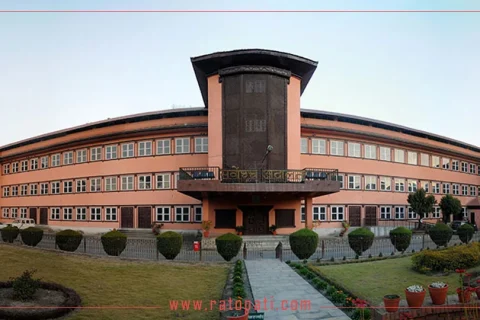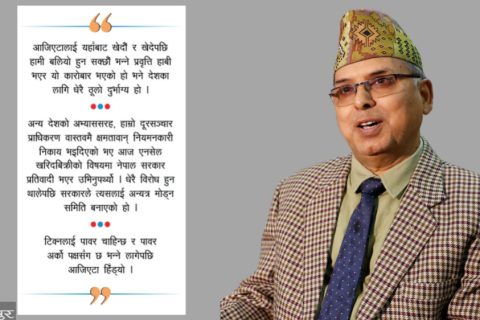
Munshi Shew Shunker Singh & Pandit Shri Gunanand, Nepal: History of the Country and the People (New Delhi: Cosmo Publications, 1983) (Originally London: Cambridge University Press, 1877) (Edited by Daniel Wright)
Originally published in 1877, the book Nepal: History of the Country and People, translated by Munshi Shew Shunker Singh and Pandit Shri Gunanand, is one of the earliest accounts of the country. The book is the translation of Vansavali or Genealogical History of Nepal.
The original manuscript of the book, according to editor Daniel Wright, was written in Parbate with an admixture of Sanskrit and Newari and was in the possession of Professor Cowell, a scholar of Sanskrit, at Cambridge. Wright also mentions about another draft, “or at all events a similar work, recognized by the Gorkhas and the Hindu races of the country, and its copies were in the British Museum and the University Library of Cambridge.”
The history of Nepal, as covered by the book, is basically the history of the valley of Kathmandu. It is a mix of myths, stories handed down from the past, and some truths and realities. Beginning with the mythological period of the history and extending through the Satya, Treta and Dwapar ages, the book contains numerous curious legends regarding the temples, towns, and holy places of the country.
Editor Daniel Wright, who had the opportunity to spend ten years in Kathmandu Valley, has topped up the book with his Introductory Sketch. In its preface, he has pointed out that the translator Shew Shunker Singh, who was the Mir Munshi attached to the British Residency in Kathmandu at that time, had lived in Nepal for nearly thirty years. The Munshi was assisted, when necessary, by Pandit Shri Gunanand, a native of Nepal, residing at Patan, and whose ancestors, for many generations, according to Daniel Wright, have been compilers of this history. Wright has admitted that he himself was not an oriental scholar and had nothing to do with the translation beyond revisiting it for publication and adding a few notes regarding the customs and places mentioned. According to him, the illustrations in the book are copies of drawings. These drawings were made for him by a native and the portraits photographs taken by a friend.
The book makes an interesting read. It states that even though the country is small in its size, it possess a great variety of races in its population, the principals being Gorkhas, decidedly the best-dressed part of the population, Newars, Magars, Gurungs, Limbus, Kirats, Bhotelis and Lepchas. The Khas and Magar castes have been described as those who came to the Valley with King Mukunda Sen, a brave and powerful monarch. They introduced ‘sinki’ and ‘hakuwa’ rice in the valley. All Nepalese, according to the book, consume a large quantity of tea, which is imported from Tibet, as much as possible. Hinting at absence of educational provisions, it has been pointed out that the subject of schools and colleges may be treated in Nepal as briefly as that of “snakes in Ireland.” Commenting on the sanitary situation, Daniel Wright speaks aloud: “Kathmandu may be said to be built on a dunghill in the middle of latrines.”
This is probably the only book based on Nepal that explains why Nepal has been traditionally described as the country cursed by a ‘sati.’ As the story is given, King Laxmi Narsinha Malla of Kantipur was served by a Kaji named Bhima Malla, who was his great well-wisher. He established thirty-two shops in the city and also sent Nepalese traders to Bhot. He visited Lhasa and sent back to Kantipur a large quantity of gold and silver. He also negotiated with Lhasa authority to return the property of Nepalese subjects dying there to the Nepalese government. Kaji Bhim Malla also brought Kuti, a Tibetan village, under the jurisdiction of Nepal. His services to the King were thus immense. He was even desirous of extending the rule of Laxmi Narsinha Malla, the 16th century King who is attributed of building the Kasthmandap (Maru Sattal) in 1595, over the whole country. However, some people behind the scene persuaded the King that Bhima Malla was aiming at making himself King, and hence, the King put him to death. His wife became a sati and uttered the curse, “May there never be ‘bibeka’ (sound judgment) in this durbar.” The authors of this 1877 book quickly acknowledge in the foot note below: “And her curse seems to have stuck to the country to the present time.” The year 1877 was also the year when Prime Minister Jung Bahadur Rana, who has been frequently referred to in the book, died, creating another wave of instabilities in the country.
Daniel Wright points out in the Introductory Sketch that Nepalese lawyers are not held in much estimation in the country. As the chief justice got a very meager salary of some two hundred rupees a month, the inducements for bribery and corruption were great. As a point of solace, Wright mentions that making an appeal to the Council, which practically means Sir Jung Bahadur, “justice is on the whole pretty fairly administered.” To Jung Bahadur’s credit, Wright clarifies that the old savage code of punishments, which involved mutilations and stripes among other methods, was abolished.
“Though the poor, people in general are contented [in Nepal] they have few taxes to pay, and their customs and prejudices are not interfered with. Justice is fairly administered, and the ‘law’s delays’ are by no means so great as in more civilized regions. There are no legal harpies to foment litigation, no municipal corporations, no road-funds, no educational taxes, nor any of the thousand and one innovations that so exasperate the subjects of British India …In extradition cases, unless the Nepalese are utterly indifferent in the matter, it is almost impossible to obtain the arrest of a criminal.”
In the Appendix, Daniel Wright has pulled together the list of his great collection of Sanskrit manuscripts bought through the Pandits residing at Bhatgaon and Kathmandu. Some of them are believed to be among the oldest, if not the very oldest, Sanskrit manuscripts in Europe. The book has immense historical value. In the end, the worth of the book must be judged by what it has captured from the mythological or the real history of Nepal.









